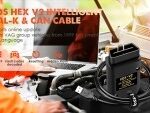Converting a 1994 Toyota Camry from OBD1 to OBD2 can sometimes lead to unexpected issues, such as a no-start condition. While the conversion itself doesn’t directly cause this problem, it can complicate diagnostics. This article explores potential causes and troubleshooting steps for a no-start 94 Camry after an OBD1 to OBD2 conversion.
Verifying Basics: Spark, Fuel, and Air
Before delving into OBD-specific issues, ensure the fundamentals are in place: spark, fuel, and air. A strong spark at the spark plug tips during cranking is crucial. Similarly, confirm the engine cranks robustly. If both are present, try introducing starter fluid into the intake manifold. A lack of even a sputter suggests a deeper issue beyond basic ignition.
Compression and Timing: Critical Checks
If starter fluid doesn’t help, a compression test is the next logical step. However, before conducting this test, verify the valve timing. Incorrect timing can not only lead to inaccurate compression readings but also potentially damage the engine during the test. A timing belt or chain that’s off even a single tooth can prevent the engine from starting.
Addressing Flooding: A Less Common Possibility
While less likely in a 1994 Camry, a flooded engine can mimic a no-start condition even with good spark and fuel. If the spark plug tips are wet with fuel, this indicates flooding. Allowing the engine to sit overnight with the spark plugs removed can help the excess fuel evaporate. Remember, certain fuel system tests can inadvertently flood the engine.
Diagnostic Trouble Codes (DTCs) and the Throttle Position Sensor (TPS)
Accessing diagnostic trouble codes (DTCs) on a 94 Camry can be tricky. Some models require manipulating the gas pedal or bridging specific diagnostic terminals with the key off, then turning the key to the on position to initiate the code blinking sequence. A constantly flashing code, often code 51, usually indicates a functional throttle position sensor (TPS). The absence of any codes might point to a faulty TPS, although this is less likely to cause a complete no-start.
Airflow Obstructions: Overlooked Culprits
Don’t overlook simple obstructions in the airflow. A severely clogged air filter, a blocked catalytic converter, or even something as unusual as a blockage in the exhaust pipe can prevent the engine from starting. Thoroughly inspect the entire intake and exhaust system for any restrictions.
Conclusion: Systematic Troubleshooting for a 94 Camry No-Start
Troubleshooting a no-start condition in a 94 Camry after an OBD1 to OBD2 conversion requires a systematic approach. Begin with the basics—spark, fuel, and air—then proceed to more advanced diagnostics like compression and timing checks. Don’t rule out less common issues like flooding or airflow obstructions. By methodically eliminating potential causes, you can pinpoint the problem and get your Camry running smoothly again.
